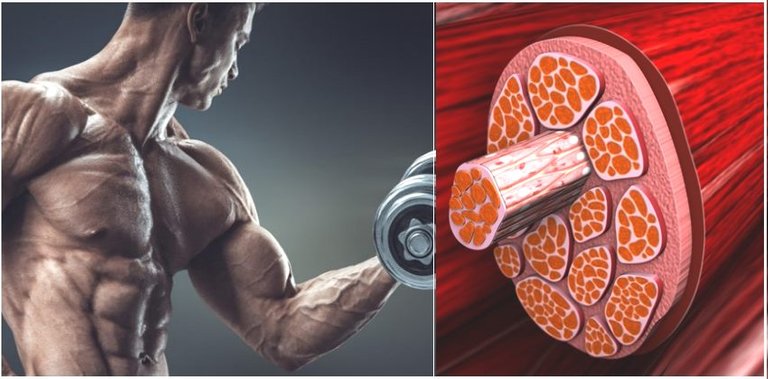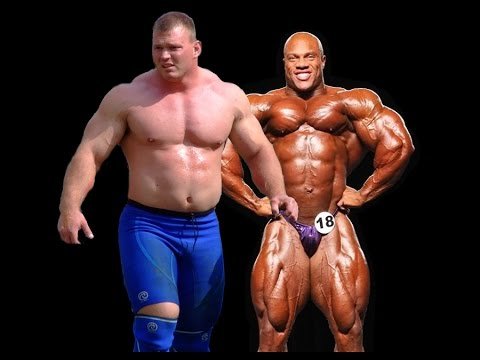Muscle growth - muscle hypertrophy
Many people want to improve their body by adding on muscle or shaping those that we already have. To achieve your goal and change your figure you got to target three things - body fat, muscle mass and water level of your body. This article will explain you how our muscles change, why and when it happens and how to induce so called muscle hypertrophy.

image source
Lets say you never really worked out or trained any sport discipline. Your body is used to your everyday life in way you taught it to be (genes also play role but thats topic for another article). If so, you probably don't have a lot of muscle mass and lifting heavy objects, jogging or any abnormal physical activity may be hard for you. When you decide to start to work out you gonna have hard time at start. You'll tire easily and feel pain next day in body parts that you used during workout. Pain comes from so called DOMS (delayed onset muscle soreness) which is basically state in which your muscle fibers are damaged (microtrauma). To prevent further damage, your muscles start to adapt to exercise type that previously damaged them. Your muscle fibers get stronger, more dense and endurant. To make it possible we need to provide our body with materials to rebuild it, in other words - nutrients. If you eat enough proteins, carbs and fats, your muscles repair themselves and in process they get bigger.
Types of hypertrophy
- sarcoplasmic - increase in storage space for glycogen in muscle
- myofibrillar - increase in myofibril(muscle cell unit) size

image source
Both of these rarely occur independently of one another but specific type of training will make one of them more dominant. Sarcoplasmic hypertrophy causes volume of sarcoplasmic fluid to increase but doesn't really improve strength whereas myofibrillar makes your muscle stronger as well as increase their size a bit. It is said that bodybuilder workout causes more sarcoplasmic hypertrophy and powerlifter training will more likely result in increased myofibrillar.
Now we can correctly guess that bodybuilders will usually have bigger muscles than powerlifters and thats because sarcoplasmic hypertrophy causes more muscle growth than myofibrillar.
Where is the difference ?
Imagine two guys - bodybuilder and powerlifter. Both of them will most likely be bigger than normal guy who doesn't train. But if you compare olympic level weightlifter with Mr. Olympia bodybuilder contestant you will notice the difference. Their skeletal muscles might be of same size but their structure is different. Bodybuilder will usually possess more dense muscles and less body fat (of course difference is partially caused by diet) whereas powerlifter will be big as well yet his body will appear less ripped.
Key to understand why it happens is to look closely at their workout routine.

image source
Bodybuilder usually trains with 75-85% max weight, do 3-4 series of single exercise with rep range of 8-12, followed by other exercises that target body part that train with specific workout focused on usually 2 body parts. They often choose to isolate muscle parts to focus even more on targeted muscle.
Powerlifter will most likely train with 85-100% max weight, do 1-3 series of single exercise with rep range of 2-6, followed by longer period of rest between exercises, use more compound techniques and basically use less exercises during workout.
Now we get to understand why different athletes from different disciplines have different bodies. Their type of training determines their skeletal muscles size and look. You can bet that bodybuilders are masters of hypertrophy. They tend to do everything to make it happen. Specific workout types, proper nutrition and supplement use as well as anabolic steroids in some cases. All of these trigger hypertrophic response.

image source
With that in mind you may wonder - How can I contribute to maximise muscle hypertrophy ?
In this section I will try to give you as many methods as possible to trigger and keep muscle hypertrophy going.
strength training - as simple as it sounds its still the best way to stimulate hypertrophy. As mentioned before, some types of specific exercises are better in case of muscle growth. Try to workout at least 3 times a week on gym with free weights and forget about machines for now. Determine your maximum load by trying to do exercise in way that you can lift only once with all your strength - that is your maximal load - now use 75-85% of it and aim to do 3 or 4 series with 8 - 12 repetition range. Its advised to train 2 muscle groups on one workout so try to alternate between two body parts with exercises. For example - 3 series of flat press with 30s - 1.5min break in between - followed by 3 series of bent over barbell row - followed by 3 series of incline press and so on. Try not to do more than 3 exercise per one muscle group when u start working out because it will most likely have adverse effect to what you aim for.
proper diet - Damaging muscles without rebuilding them will most likely shrink them or cause minimal muscle growth. You should give your body "bricks" it needs to rebuild and those are nutrients. Proteins, sugars and fats - all of these are needed with no exception. Here is an example taken from my previous article about carbohydrates - Male, age 19-30, 85kg weight who works out with medium intensity 4 times a week should consume 3450 kcal. If he wants to increase muscle mass he should raise his caloric surplus by at least 500 kcal which summed up gives us 3950 kcal. If he uses 1 : 0,9 : 4 nutrient ratio he should consume about 153g of proteins, 137,7g of fats and about 612g od carbs; from which 64% should be starch. There are many calorie calculators on web so I advice anyone to calculate those for themselves to get most precise answer.
supplementation - Number of micro and macro elements we can provide our body with is limited by what kind of food we eat. If our diet is monotonous or low in vitamins etc. great help will be use of sport supplements. Many newbies think of them as steroids but thats not the case. These are mostly things that we can find in food, like vitamins, creatine or aminos. Difference is that supplements are pure extracts and except protein or carb shakes (and mixes with carbs) they wont add to our caloric intake. Most are 100% safe and will even improve your health but you should always make sure if specific product is right for you by consulting doctor or dietician. Basic supplements that I always advise to newbies are: creatine, protein powder, vitamin + mineral complexes and glutamine. These are safest and best products to enhance your muscle growth and progress.
rest - It is important to understand that human body doesn't grow muscles on gym. It happens when you recover. Whole process of rebuilding your tissues happens when you rest so make sure to not overtrain yourself and treat rest as equally important. Healthy and proper sleep is priceless for anyone but for athletes and physically active people its even more essential. When we sleep, our body releases many important hormones that cause growth and are needed in adaptation process (testosterone, human growth hormone etc. )
minimize stress - If there is one thing that is greatest enemy for us all it is stress. Not only it affects your physical and mental health but it also directly damages your body. Many hormones that are released as stress response like cortisol or adrenaline, causes catabolic response which in short makes your tissues to break down and get inflammed. To help yourself you should add some anti-stress routine to your everyday life - do what you love, spend time with your friends and family, try breathing techniques or meditation etc.
If you have any questions after reading, feel free to ask :)